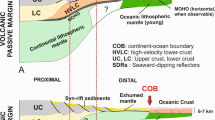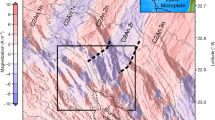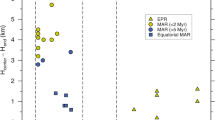Abstract
Subduction of oceanic crust into the mantle results in the relatively young Mesozoic–Cenozoic age of the current oceanic basins1, thus, hindering our knowledge of ancient oceanic lithospheres. Believed to be an exception, the eastern Mediterranean Sea (containing the Herodotus and Levant basins) preserves the southern margin of the Neotethyan, or older, ocean2,3,4. An exceptionally thick sedimentary cover5 and a lack of accurate magnetic anomaly data have led to contradicting views about its crustal nature and age2,3,4,5,6,7,8,9. Here I analyse total and vector magnetic anomaly data from the Herodotus Basin. I identify a long sequence of lineated magnetic anomalies, which imply that the crust is oceanic. I use the shape, or skewness, of these magnetic anomalies to constrain the timing of crustal formation and find that it formed about 340 million years ago. I suggest that this oceanic crust formed either along the Tethys spreading system, implying the Neotethys Ocean came into being earlier than previously thought, or during the amalgamation of the Pangaea Supercontinent. Finally, the transition from the rather weak and stretched continental crust found in the Levant Basin6,7,8 to the relatively strong oceanic Herodotus crust seems to guide the present-day seismicity pattern as well as the plate kinematic evolution of the region.
This is a preview of subscription content, access via your institution
Access options
Subscribe to this journal
Receive 12 print issues and online access
$259.00 per year
only $21.58 per issue
Buy this article
- Purchase on SpringerLink
- Instant access to full article PDF
Prices may be subject to local taxes which are calculated during checkout




Similar content being viewed by others
References
Müller, R. D., Sdrolias, M., Gaina, C. & Roest, W. R. Age, spreading rates, and spreading asymmetry of the world’s ocean crust. Geochem. Geophys. Geosyst. 9, Q04006 (2008).
Garfunkel, Z. Constraints on the origin and history of the Eastern Mediterranean basin. Tectonophysics 298, 5–35 (1998).
Stampfli, G. M. & Borel, G. D. A plate tectonic model for the Paleozoic and Mesozoic constrained by dynamic plate boundaries and restored synthetic oceanic isochrons. Earth Planet. Sci. Lett. 196, 17–33 (2002).
Domeier, M. & Torsvik, T. H. Plate tectonics in the late Paleozoic. Geosci. Front. 5, 303–350 (2014).
de Voogd, B. et al. Two-ship deep seismic soundings in the basins of the Eastern Mediterranean Sea (Pasiphae cruise). Geophys. J. Int. 109, 536–552 (1992).
Ben-Avraham, Z., Ginzburg, A., Makris, J. & Eppelbaum, L. Crustal structure of the Levant Basin, eastern Mediterranean. Tectonophysics 346, 23–43 (2002).
Cowie, L. & Kusznir, N. Mapping crustal thickness and oceanic lithosphere distribution in the Eastern Mediterranean using gravity inversion. Petrol. Geosci. 18, 373–380 (2012).
Netzeband, G. L. et al. The Levantine Basin—crustal structure and origin. Tectonophysics 418, 167–188 (2006).
Rybakov, M., Goldshmidt, V., Hall, J. K., Ben-Avraham, Z. & Lazar, M. New insights into the sources of magnetic anomalies in the Levant. Russian Geol. Geophys. 52, 377–397 (2011).
Stampfli, G., Marcoux, J. & Baud, A. Tethyan margins in space and time. Palaeogeogr. Palaeoclimatol. Palaeoecol. 87, 373–409 (1991).
Stampfli, G. M. in CROP PROJECT: Deep Seismic Exploration of the Central Mediterranean and Italy (ed. Finetti, I. R.) 747–766 (Elsevier, 2005).
Garfunkel, Z. Origin of the Eastern Mediterranean basin: a reevaluation. Tectonophysics 391, 11–34 (2004).
Sandwell, D. T., Müller, R. D., Smith, W. H. F., Garcia, E. & Francis, R. New global marine gravity model from CryoSat-2 and Jason-1 reveals buried tectonic structure. Science 346, 65–67 (2014).
Granot, R., Cande, S. C. & Gee, J. S. The implications of long-lived asymmetry of remanent magnetization across the North Pacific fracture zones. Earth Planet. Sci. Lett. 288, 551–563 (2009).
Pockalny, R. A., Smith, A. & Gente, P. Spatial and temporal variability of crustal magnetization of a slowly spreading ridge: mid-Atlantic ridge (20°–24° N). Mar. Geophys. Res. 17, 301–320 (1995).
Hosford, A. et al. Crustal magnetization and accretion at the Southwest Indian Ridge near the Atlantis II fracture zone, 0–25 Ma. J. Geophys. Res. 108, 2169 (2003).
Isezaki, N. A new shipboard three-component magnetometer. Geophysics 51, 1992–1998 (1986).
Korenaga, J. Comprehensive analysis of marine magnetic vector anomalies. J. Geophys. Res. 100, 365–378 (1995).
Torsvik, T. H. et al. Phanerozoic polar wander, palaeogeography and dynamics. Earth Sci. Rev. 114, 325–368 (2012).
Schouten, H. & Cande, S. C. Paleomagnetic poles from marine magnetic anomalies. Geophys. J. R. Astron. Soc. 44, 567–575 (1976).
Dyment, J., Cande, S. C. & Arkani-Hamed, J. Skewness of marine magnetic anomalies created between 85 and 40 Ma in the Indian Ocean. J. Geophys. Res. 99, 24121–24134 (1994).
Ogg, J. G. in The Geologic Time Scale 2012 (eds Gradstein, F. M., Ogg, J. G., Schmitz, M. D. & Ogg, G. M.) 85–114 (Elsevier, 2012).
Tari, G., Hussein, H., Novotny, B., Hannke, K. & Kohazy, R. Play types of the deep-water Matruh and Herodotus basins, NW Egypt. Petrol. Geosci. 18, 443–455 (2012).
Salamon, A., Hofstetter, A., Garfunkel, Z. & Ron, H. Seismicity of the eastern Mediterranean region: perspective from the Sinai subplate. Tectonophysics 263, 293–305 (1996).
Stampfli, G. M., Hochard, C., Vérard, C., Wilhem, C. & vonRaumer, J. The formation of Pangea. Tectonophysics 593, 1–19 (2013).
Sengör, A. M. C. The Cimmeride orogenic system and the tectonics of Eurasia. Geol. Soc. Am. 195, 1–82 (1984).
Pastor-Galán, D., Groenewegen, T., Brouwer, D., Krijgsman, W. & Dekkers, M. J. One or two oroclines in the Variscan orogen of Iberia? Implications for Pangea amalgamation. Geology 43, 527–530 (2015).
Smith, W. H. F. & Sandwell, D. T. Global sea floor topography from satellite altimetry and ship depth soundings. Science 277, 1956–1962 (1997).
Gardosh, M. A., Garfunkel, Z., Druckman, Y. & Buchbinder, E. in Evolution of the Levant Margin and Western Arabia Platform Since the Mesozoic (eds Homberg, C. & Bachmann, M.) 9–36 (Geol. Soc. Spec. Publ., 341, Geological Society of London, 2010).
Argus, D. F., Gordon, R. G. & DeMets, C. Geologically current motion of 56 plates relative to the no-net-rotation reference frame. Geochem. Geophys. Geosyst. 12, Q11001 (2011).
Engels, M., Barckhausen, U. & Gee, J. S. A new towed marine vector magnetometer: methods and results from a Central Pacific cruise. Geophys. J. Int. 172, 115–129 (2008).
Thébault, E. et al. International Geomagnetic Reference Field: the 12th generation. Earth Planets Space 67, 67–79 (2015).
Acknowledgements
I thank the captain, I. Katzman, of the RV Mediterranean Explorer and the entire staff of EcoOcean. Discussions with U. Barckhausen and M. Engels are greatly appreciated. This work was funded by the Israeli Ministry of Science, Technology and Space, grant 1151. The author was supported by the European Union Seventh Framework Program (FP7/2007–2013) under grant agreement 320496 (GEOPLATE) and the Israel Science Foundation grant 1844/12.
Author information
Authors and Affiliations
Corresponding author
Ethics declarations
Competing interests
The author declares no competing financial interests.
Supplementary information
Supplementary Information
Supplementary Information (PDF 7294 kb)
Rights and permissions
About this article
Cite this article
Granot, R. Palaeozoic oceanic crust preserved beneath the eastern Mediterranean. Nature Geosci 9, 701–705 (2016). https://doi.org/10.1038/ngeo2784
Received:
Accepted:
Published:
Issue Date:
DOI: https://doi.org/10.1038/ngeo2784




